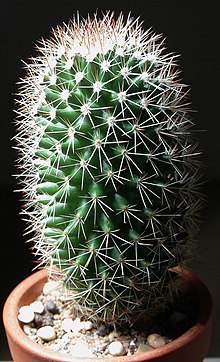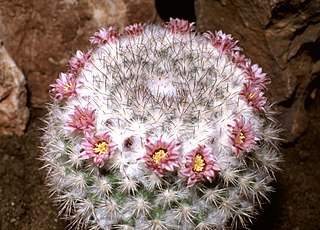
Mammillaria is one of the largest genera in the cactus family (Cactaceae), with currently 200 known species and varieties recognized. Most of the mammillaria are native to Mexico, but some come from the southwest United States, the Caribbean, Colombia, Venezuela, Guatemala and Honduras. The common name "pincushion cactus" refers to this and the closely related genus Escobaria.

Mammillaria albicoma is a species of plant in the family Cactaceae. It is endemic to Mexico. Its natural habitat is hot deserts. It is threatened by habitat loss.

Mammillaria albiflora is a species of plant in the family Cactaceae. It is endemic to Guanajuato state in central Mexico. Its natural habitat is hot deserts. It is a Critically endangered species, threatened by habitat loss.
Mammillaria anniana is a species of plant in the family Cactaceae. It is endemic to Tamaulipas state of northeastern Mexico. Its natural habitat is hot deserts. It is a Critically endangered species, threatened by habitat loss.

Mammillaria aureilanata is a species of plant in the family Cactaceae. It is endemic to Mexico. Its natural habitat is hot deserts.

Mammillaria glochidiata is a species of plant in the family Cactaceae. It is endemic to Mexico. Its natural habitat is hot deserts. It was classed as Extinct in the wild but since 2013, it has been classed as Critically Endangered by the IUCN Red List.
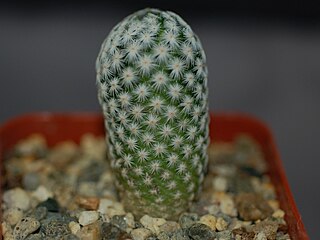
Mammillaria herrerae is a species of plant in the family Cactaceae. It is endemic to Mexico where it is confined to Querétaro. Its habitat is semi-desert shrubland. It is threatened by habitat loss and illegal collection. In a 20-year period over 95% of the species population was illegally collected or sold. Mammillaria herrerae has an IUCN rating of critically endangered.

Mammillaria mathildae is a species of plant in the family Cactaceae. It is endemic to Querétaro, Mexico. Its natural habitat is hot deserts. It is of IUCN Red List Vulnerable status and threatened by habitat loss.

Mammillaria microhelia is a species of plant in the family Cactaceae. It is endemic to Mexico. Its natural habitat is hot deserts.

Mammillaria pennispinosa is a species of cactus. It is endemic to Mexico, where it is known only from a single location in Durango. Its total population is fewer than 1250 individuals. They grow on volcanic rock in desert habitat.
Mammillaria rettigiana is a species of plant in the family Cactaceae. It is endemic to Mexico. Its natural habitat is hot deserts. It is threatened by habitat loss.

Mammillaria sanchez-mejoradae is a species of plant in the family Cactaceae. It is endemic to Nuevo León state of northeastern Mexico. Its natural habitat is hot deserts. It is a Critically endangered species, threatened by habitat loss.
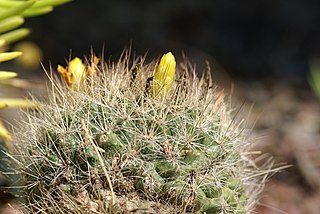
Mammillaria weingartiana is a species of plant in the family Cactaceae. It is endemic to Nuevo León state, Mexico.

Mammillaria zeilmanniana is a species of cactus. It is endemic to Mexico, where it is known only from Guanajuato. It grows in a narrow canyon usually near water where there is high humidity, its total population is fewer than 250 individuals. It is threatened by illegal collection for the horticultural trade. Recent studies link this species to Mammillaria crinita.

Mammillaria geminispina, the twin spined cactus, is a species of flowering plant in the family Cactaceae, native to central Mexico. It grows to 25 cm (10 in) tall by 50 cm (20 in) broad. The clustering spherical stems, 8 cm in diameter, are covered in white down and white spines. Carmine pink flowers are borne in summer and autumn.

Mammillaria glassii is a species of cactus in the subfamily Cactoideae. It is a small, clumping cactus with "fluffy white spines." M. glassii is native to Mexico in the states of Coahuila and Nuevo León.

Mammillaria bocasana is a species of cactus in the subfamily Cactoideae. It is often sold as a "powder puff" cactus, and also as a "Powder Puff Pincushion." The plant is protected from collecting in the wild in Mexico.
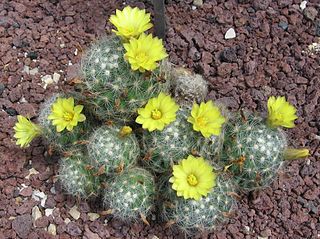
Mammillaria baumii is a species of cactus in the subfamily Cactoideae. It is endemic to Mexico. It was named for botanist Hugo Baum.

Mammillaria uncinata is a species of cactus in the family Cactaceae. It is endemic to Mexico.

Mammillaria laui is a species of cactus in the genus Mammillaria, native to Tamaulipas state in Mexico. A number of subspecies were described, occurring along an elevation gradient; these are no longer accepted. It is listed as Critically Endangered (CR) in the wild. As Mammillaria lauii it has gained the Royal Horticultural Society's Award of Garden Merit.
